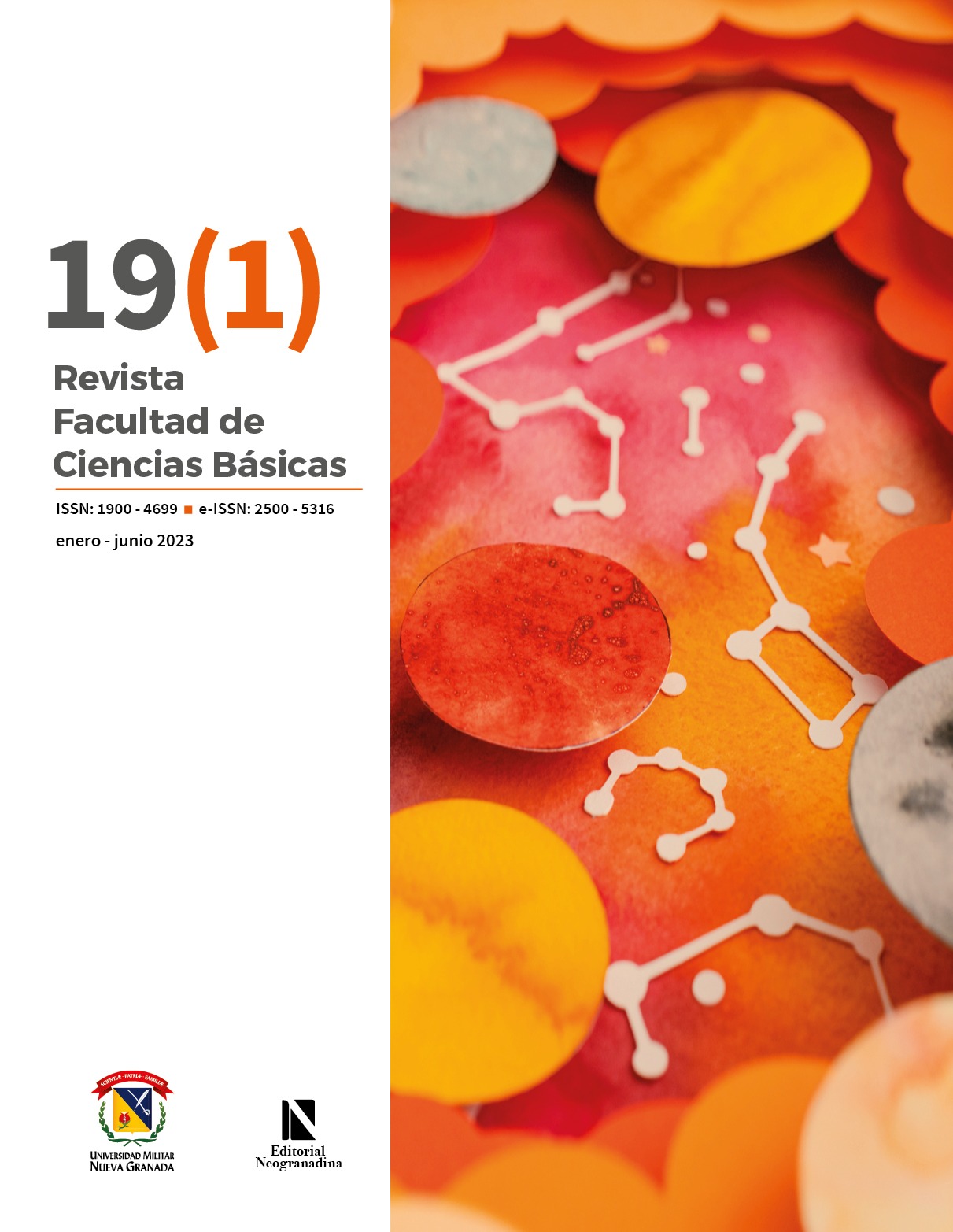Evaluation of Classification Algorithms for Deforestation Identification in the Indigenous Reserve Llanos del Yarí Yaguara II
Abstract
Deforestation has become a critical issue in many regions of the world, particularly in areas of high environmental and cultural value, such as the Indigenous Reserve Llanos del Yarí Yaguara II. Understanding the extent and impact of deforestation in this reserve requires a solid methodological approach to effectively analyze changes in land cover. This paper analyzes different classification algorithms to determine which provides the highest reliability in identifying land cover changes due to deforestation, in combination with knowledge of the area and maps of land use and cover changes. Remote sensing, a widely used tool for this purpose, is employed with two unsupervised classifi- cation algorithms and five supervised classification algorithms using data from two satellite images, Landsat 8 and Landsat 9. The classification of satellite images in the indigenous reserve reveals low accuracy in unsupervised classification algorithms. In contrast, supervised algorithms, particularly the Support Vector Machine and Mahalanobis Distance, achieve 97 % accuracy, effectively supporting the identification of deforested areas. The application of the Maximum Likelihood method in ArcGIS for multitemporal analysis confirms the drastic reduction of areas classified as abundant vegetation. Additionally, the significant loss of dense forest in the reserve over six years is highlighted, underscoring the urgency of coordinated actions to prevent further ecological and social damage. The results of this study emphasize the importance of using supervised classification algorithms for high-precision deforestation mapping and provide a reliable foundation for environmental management and policy decision-making in indigenous territories.
Downloads
References
E. Tamayo, P. Morales y J. Ochoa-Quintero, “El rol de los territorios indígenas en la contención de la deforestación”, en Biodiversidad 2020. Estado y tendencias de la biodiversidad continental de Colombia, 2021, p. 203.
S. L. Mosquera, E. Tamayo y C. Tapia, “Territorios colectivos y biodiversidad”, en Biodiversidad 2015, en Estado y Tendencias de la Biodiversidad Continental de Colombia. [En línea]. Disponible en: http://reporte.humboldt.org.co/biodiversidad/2015/cap4/406/
R. Guzmán, M. Bezada e I. Rodríguez-Santalla, “Cartografía de cobertura del suelo mediante datos de teledetección en la planicie de desborde del río Apure (Venezuela)”, Cuadernos de Investigación Geográfica, vol. 49, núm. 1, pp. 113-137, jul. 2023, DOI: https://doi.org/10.18172/cig.5607
A. Soccolini y M. Vizzari, “Predictive modelling of maize yield using Sentinel 2 ndvi”, en Computational Science and Its Applications – ICCSA 2023 Workshops, Springer, Cham., vol. 14107, 2023, pp. 327-338.
I. D. Ávila-Pérez et al., “Evaluación de cuatro algoritmos de clasificación de imágenes satelitales Landsat-8 y Sentinel-2 para la identificación de cobertura boscosa en paisajes altamente fragmentados en Costa Rica”, Revista de Teledetección, núm. 57, pp. 37-49, dic. 2020, DOI: https://doi.org/10.4995/raet.2020.13340
M. F. Baig et al., “Comparative analysis of support vector machine and maximum likelihood classifications using satellite images of Selangor, Malaysia”, Sustainability and Resilience Conference: Climate Change, pp. 405-409, 2021.
G. Amin et al., “Assessment of machine learning algorithms for land cover classification in a complex mountainous landscape”, Journal of Geovisualization and Spatial Analysis, vol. 8, ago. 2024.
H. Ouchra, A. Belangour y A. Erraissi, “Land cover mapping using Landsat 8 data and supervised learning classifiers in Casablanca region, Morocco”, en 2023 4th International Conference on Data Analytics for Business and Industry, ICDABI 2023, 2023, pp. 12-17, DOI: https://doi.org/10.1109/ICDABI60145.2023.10629339
A. Kumar et al., “Comparison of regression techniques and integration models using machine learning”, en Proceedings of International Conference on Contemporary Computing and Informatics, IC3I 2023, 2023, pp. 1349-1353, DOI: https://doi.org/10.1109/IC3I59117.2023.10397945
Z. Sun et al., “A deep learning-based spatio-temporal ndvi data fusion model”, J Resour Ecol, vol. 15, núm. 1, pp. 214- 226, 2024, DOI: https://doi.org/10.5814/j.issn.1674-764x.2024.01.019
M. D. Shekede et al., “Using Landsat satellite imagery to monitor the spatial and temporal dynamics of aquatic weed extent in Lakes Chivero and Manyame, located in an urban catchment of Zimbabwe”, Water SA, vol. 49, núm. 1, pp. 46-55, 2023, DOI: https://doi.org/10.17159/wsa/2023.v49.i1.3950
C. Suwanprasit y J. Strobl, “Aboveground biomass estimation in an upland tropical evergreen forest environment from landsat 7 etm+”, International Journal of Geoinformatics, vol. 16, núm. 4, pp. 39-50, 2020.
M. Li, “Comparing different methods for biomass modeling over tropical region based on Landsat Data”, en Procee- dings of SPIE - The International Society for Optical Engineering, 2023, DOI: https://doi.org/10.1117/12.2667877
P. K. Soni et al., “Urban land cover and land use classification using multispectral sentinal-2 imagery”, Multimed Tools Appl, vol. 81, núm. 26, pp. 36853-36867, 2022, DOI: https://doi.org/10.1007/s11042-021-10991-0
S. Rodriguez Corujo, Detección de cambios en imágenes multibanda mediante reducción de su dimensionalidad, Tesis BA, Departamento de Ingeniería Informática, Universidad Politécnica de Madrid, Madrid, 2020.
A. Elen y E. Avuçlu, “Standardized variable distances: A distance-based machine learning method”, Appl Soft Com- put, vol. 98, 2021, DOI: https://doi.org/10.1016/j.asoc.2020.106855
R. Thakur y P. Panse, “Classification performance of land use from multispectral remote sensing images using De- cision Tree, K-Nearest Neighbor, Random Forest and Support Vector Machine Using EuroSAT Data”, International Journal of Intelligent Systems and Applications in Engineering, vol. 10, núm. 1s, pp. 67-77, 2022.
C.-L. Fan, “Using convolutional neural networks to identify illegal roofs from unmanned aerial vehicle images”, Architectural Engineering and Design Management, vol. 20, núm. 2, pp. 390-410, 2024, DOI: https://doi.org/10.1080/17452007.2023.2244949
D. Landgrebe, “Hyperspectral image data analysis”, IEEE Signal Process Mag, vol. 19, núm. 1, pp. 17-28, 2002, DOI: https://doi.org/10.1109/79.974718
S. Basheer et al., “Comparison of land use land cover classifiers using different satellite imagery and machine learning techniques”, Remote Sens (Basel), vol. 14, núm. 19, 2022, DOI: https://doi.org/10.3390/rs14194978
Y. Shi et al., “Urban land use and land cover classification using multisource remote sensing images and social media data”, Remote Sens (Basel), vol. 11, núm. 22, 2019, DOI: https://doi.org/10.3390/rs11222719
G. Khadanga y K. Jain, Optimum selection of image object attributes for object-based image analysis and high classification accuracy, vol. 2010 CCIS. 2024. DOI: https://doi.org/10.1007/978-3-031-58174-8_21
P. Sampurnima et al., Hyperspectral image classification using stochastic gradient descent based support vector machi- ne, vol. 10. 2020, DOI: https://doi.org/10.1007/978-3-030-39033-4_8
G. Song y Q. Wang, “Species classification from hyperspectral leaf information using machine learning approaches”, Ecol Inform, vol. 76, 2023, DOI: https://doi.org/10.1016/j.ecoinf.2023.102141
V. Venugopal et al., “Analysis of salinity indices using svm based approach of Ballari Town, India”, Mathematical Modelling of Engineering Problems, vol. 10, núm. 5, pp. 1803-1810, 2023, DOI: https://doi.org/10.18280/mmep.100532
A. F. B. Firmansyah, “Comparison of supervised algorithms for built-up classification in Indonesia metropolitan”, en AIP Conference Proceedings, 2023, DOI: https://doi.org/10.1063/5.0125960
G. Cheng et al., “Change detection methods for remote sensing in the last decade: A comprehensive review”, Remote Sens (Basel), vol. 16, núm. 13, 2024, DOI: https://doi.org/10.3390/rs16132355
Ministerio de Ambiente y Desarrollo Sostenible e Instituto Amazónico de Investigaciones Científicas-SINCHI, Ocu- pación y usos indebidos de la tierra en el resguardo indígena Yaguara II, Bogotá: SINCHI, 2022.
T. Pardo, “Retornar para cuidar el bosque: la cruzada de Yaguara II”, abril de 2020. [En línea]. Disponible en: https://tierraderesistentes.com/es/2020/04/19/retornar-para-cuidar-el-bosque-la-cruzada-de-yaguara-ii/
Fundación para la Conservación y el Desarrollo Colombia (FCDS), “Proyecto Llanos del Yarí Yaguara II, comunidad que reconstruye una vida digna, sostenible y en paz en su territorio - FCDS - Fundación para la Conservación el Desarrollo Colombia”. [En línea]. Disponible en: https://fcds.org.co/proyectos/proyecto-llanos-del-yari-yaguara-ii-comunidad-que-reconstruye-una-vida-digna-sostenible-y-en-paz-en-su-territorio/
M. E. G. Vélez, “Colonización, memoria y resistencia. Construcción del territorio Yaguara II (Llanos del Yarí, Colombia) desde el destierro”, Bol Antropol, vol. 27, núm. 44, pp. 68-88, jun. 2013, DOI: https://doi.org/10.17533/udea.boan.15609
H. García Rodas, “Reconstrucción de la memoria colectiva de la comunidad indígena Yaguara II en los llanos del Yari.”, Corporación Universitaria Minuto de Dios, 2017. [En línea]. Disponible en: https://repository.uniminuto.edu/handle/10656/5222
B. F. Vieira, J. J. Costa, y A. Q. de Almeida, “Temporal analysis of the Normalized Difference Vegetation Index (ndvi) in Serra da Caboronga, in Ipirá-BA | Análise temporal do Índice de Vegetação por Diferença Normalizada (ndvi) na Serra da Caboronga, em Ipirá-BA”, Revista Brasileira de Geografia Fisica, vol. 16, núm. 6, pp. 3593-3606, 2023, DOI: https://doi.org/10.26848/rbgf.v16.6.p3593-3606
Esri, “Asistente para la clasificación de imágenes”, 2023. [En línea]. Disponible en: https://pro.arcgis.com/es/proapp/3.1/help/analysis/image-analyst/the-image-classification-wizard.htm
Consejo Nacional de Rectores (CONARE), “Tutorial ENVI 5.0, Georreferenciación y clasificación Imágenes sensor MASTER, 2005”, 2014. [En línea]. Disponible en: https://repositorio.conare.ac.cr/bitstream/handle/20.500.12337/3152/Vargas_C_Tutorial_ENVI_5-0-Georeferenciacion_clasificacion_imagenes_sensor_MASTER_2014.pdf?sequence=3&isAllowed=y
H. Rosales et al., “Determinación de tipos de cobertura vegetal mediante índices espectrales usando teledetección, Reserva Nacional de Lachay, 2020”, 2020.
V. Guzmán y O. Adair, “Aplicación web para la ejecución de algoritmos descriptivos de minería de datos para usuarios no expertos”, UAEH: Universidad Autónoma del Estado de Hidalgo, México, 2024.
Zhu Wang et al., “Spatiotemporal characteristics and natural forces of grassland ndvi changes in Qilian Mountains from a sub-basin perspective”, Ecol Indic, núm. 157, p. 13, 2023, DOI: https://doi.org/10.1016/j.ecolind.2023.111186
K. Hussien et al., “Spatiotemporal trends of ndvi and its response to climate variability in the Abbay River Basin, Ethiopia”, Heliyon, núm. 9, 2023, DOI: https://doi.org/10.1016/j.heliyon.2023.e14113
D. Song et al., “Influence of mining on vegetation in semi-arid areas of western China based on the coupling of above ground and below ground – A case study of Daliuta coalfield”, Ecol Indic, vol. 161, 2024, DOI: https://doi.org/10.1016/j.ecolind.2024.111964
E. Sanz et al., “Clustering arid rangelands based on ndvi Annual Patterns and Their Persistence”, Remote Sens (Basel), vol. 14, núm. 19, 2022, DOI: https://doi.org/10.3390/rs14194949
A. A. Fernández-Fierro et al., “Caracterización y dinámica de la cobertura de suelo mediante teledetección: Caso de estudio volcán Tungurahua, Ecuador”, Dominio de las ciencias, vol. 6, núm. 2, pp. 906-938, 2020, DOI: http://dx.doi.org/10.23857/dc.v6i2.1201
A. Essaadia et al., “The normalized difference vegetation index (ndvi) of the Zat valley, Marrakech: comparison and dynamics”, Heliyon, vol. 8, núm. 12, 2022, DOI: https://doi.org/10.1016/j.heliyon.2022.e12204
J. N. Adhikari et al., “Landscape-level habitat connectivity of large mammals in Chitwan Annapurna Landscape, Nepal”, Ecol Evol, vol. 14, núm. 8, 2024, DOI: https://doi.org/10.1002/ece3.70087
A. Valoix et al., “Understanding the landscape evolution of El Mogote barrier spit, Baja California Sur, Mexico, using OSL dating, satellite images and a multivariate analysis”, J South Am Earth Sci, vol. 127, 2023, DOI: https://doi.org/10.1016/j.jsames.2023.104418
D. Wang, B.-H. Tang y Z.-L. Li, “Evaluation of five atmospheric correction algorithms for multispectral remote sensing data over plateau lake”, Ecol Inform, vol. 82, 2024, DOI: https://doi.org/10.1016/j.ecoinf.2024.102666
D. V. Portela et al., “Cobertura del suelo bajo metodología Corine Land Cover para el bosque de Galilea y su área de influencia, Tolima, Colombia”, UD y la geomática, núm. 15, abr. 2020, DOI: https://doi.org/10.14483/23448407.15256
Universidad Nacional de Quilmes, “La herramienta de la teledetección: el análisis visual y el procesamiento de imágenes”. [En línea]. Disponible en: https://static.uvq.edu.ar/mdm/teledeteccion/unidad-3.html
M. A. Perea-Ardila et al., “Determinación de la cobertura y uso del suelo utilizando RapidEye en el Parque Nacional Natural Los Nevados y su zona amortiguadora en Colombia”, Revista de Ciencias Ambientales, vol. 56, núm. 2, pp. 146-174, dic. 2022, DOI: https://doi.org/10.15359/rca.56/2.8
M. Ramírez et al., “Obtaining agricultural land cover in sentinel-2 satellite images with drone image injection using random forest in google earth engine | Obtención de coberturas del suelo agropecuarias en imágenes satelitales sentinel-2 con la inyección de imágenes de dron”, Revista de Teledeteccion, vol. 2020, núm. 56, pp. 49-68, 2020, DOI: https://doi.org/10.4995/raet.2020.14102
L. Congedo, “Breve introducción a la teledetección — documentación de Semi-Automatic Classification Plugin”, 2017. [En línea]. Disponible en: https://semiautomaticclassificationmanual-v5.readthedocs.io/es/latest/remote_sen- sing.html
Y. Poveda-Sotelo, M. A. Bermúdez-Cella y P. Gil-Leguizamón, “Evaluation of supervised classification methods for the estimation of spatiotemporal changes in the Merchán and Telecom paramos, Colombia | Evaluación de métodos de clasificación supervisada para la estimación de cambios espacio-temporales de cobertura en los páramos de Merchán y Telecom, Cordillera Oriental de Colombia”, Boletín de Geología, vol. 44, núm. 2, pp. 51-72, 2022, DOI: https://doi.org/10.18273/revbol.v44n2-2022002
F. González Soto, D. Ullón y J. Loján, “Análisis multitemporal de cambios de uso del suelo en la isla Santa Cruz, archipiélago de las Galápagos, periodo 1991-2023”, Revista Ciencia y Tecnología, núm. 17, pp. 1-9, 2024, DOI: https://doi.org/10.18779/cyt.v17i1.521
J. C. Flores Cesareo et al., “Soil use cartography in the subcuenca huaquechula, Puebla, Mexico, with a combined index of satellite images | Cartografía del uso del suelo en la subcuenca Huaquechula, Puebla, México, con un índice combinado de imágenes de satélite”, Investigaciones Geográficas, núm. 101, 2020, DOI: https://doi.org/10.14350/rig.59914
I. Teijido-Murias, M. Anta, y C. López-Sánchez, “Clasificación automática de coberturas forestales a partir de imágenes Sentinel-2 y datos auxiliares mediante Google Earth Engine”, vol. 49, pp. 161-184, sep. 2023, DOI: https://doi.org/10.31167/csecfv5i49.19935
L. Rumora, M. Miler, y D. Medak, “Impact of various atmospheric corrections on sentinel-2 land cover classification accuracy using machine learning classifiers”, ISPRS Int J Geoinf, vol. 9, núm. 4, p. 277, abr. 2020, DOI: https://doi.org/10.3390/ijgi9040277
Perú. Ministerio del Ambiente Viceministerio de Desarrollo de Recursos Naturales y Dirección General de Ordenamiento Territorial, Protocolo: Evaluación de la Exactitud Temática del Mapa de Deforestación. Ministerio del Ambiente, 2014. [En línea]. Disponible en: http://repositoriodigital.minam.gob.pe/xmlui/handle/123456789/928
Copyright (c) 2024 Revista Facultad de Ciencias Básicas

This work is licensed under a Creative Commons Attribution-NonCommercial-NoDerivatives 4.0 International License.











